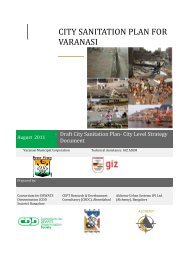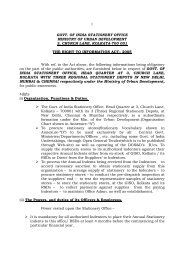CITY SANITATION PLAN - Ministry of Urban Development
CITY SANITATION PLAN - Ministry of Urban Development
CITY SANITATION PLAN - Ministry of Urban Development
You also want an ePaper? Increase the reach of your titles
YUMPU automatically turns print PDFs into web optimized ePapers that Google loves.
1500-3000 100 1500-5000 600<br />
>3000 120 >5000 1000<br />
<strong>CITY</strong> <strong>SANITATION</strong> <strong>PLAN</strong> BAREILLY<br />
To recover costs <strong>of</strong> operation, maintenance and debt servicing, the municipality decided the tariff<br />
structure through a consultative process. The tariff included a one-time deposit and a monthly tariff.<br />
They are given in Table 2. On demand from the citizens, the municipality has subsequently reduced<br />
monthly charges from Rs. 150 to Rs. 110.<br />
Impact<br />
Of the 23,000 households who paid for the services, 8,350 households were connected in the first<br />
phase, i.e. by 2005. Nearly 500 slum households out <strong>of</strong> 7,000 had sewerage connections, and 43% <strong>of</strong><br />
slum dwellers have opted for and paid for individual sewerage connections. In 2005, 14 community<br />
toilets were constructed to serve poor clusters. By the end <strong>of</strong> March 2008, all households had received<br />
sewerage connections.<br />
Sustainability<br />
The project is sustainable, as the cost towards maintaining the system is recovered from the users by<br />
means <strong>of</strong> monthly charges. There has been a regular flow <strong>of</strong> funds and timely repayment to financial<br />
institutions. Alandur sewerage project is an innovative initiative for sustainable delivery <strong>of</strong> urban<br />
services in the country. Inspired by the Alandur example, many urban local bodies, including Trichy,<br />
Tanjavur, Tirunelveli, and Ambattur, have initiated similar efforts for underground sewerage system. The<br />
Alandur experience demonstrates that mobilising people’s participation for infrastructure projects is<br />
possible through effective leadership, collective efforts and transparent procedures. Political will,<br />
effective communications, transparency and partnership with community-based organisations, are the<br />
key factors for the success <strong>of</strong> the project. Inter-departmental coordination and active involvement <strong>of</strong> all<br />
stakeholders ensured successful completion and sustenance <strong>of</strong> the project.<br />
http://www.waterawards.in/2008-winner-pr<strong>of</strong>ile-am.php<br />
ADMINISTRATIVE STAFF COLLEGE OF INDIA, HYDERABAD Page 216
















